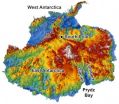(Press-News.org) Antarctica's topography began changing from flat to fjord-filled starting about 34 million years ago, according to a new report from a University of Arizona-led team of geoscientists.
Knowing when Antarctica's topography started shifting from a flat landscape to one with glaciers, fjords and mountains is important for modeling how the Antarctic ice sheet affects global climate and sea-level rise.
Although radar surveys have revealed a rugged alpine landscape under Antarctica's two-mile-thick ice sheet, the surveys tell nothing about when the continent's deep valleys formed.
"We have worked out how the landscape under the ice has changed through time," said lead author Stuart N. Thomson.
"People have speculated when the big fjords formed under the ice," he said. "But no one knows for sure until you sample the rocks or the sediments."
He and his colleagues sampled East Antarctica's rocks by examining the sediments that built up off-shore for millions of years as rocks and dirt eroded off the continent into Prydz Bay.
"We use the sediments to trace what was happening under the ice in the past," said Thomson, a research scientist in the UA department of geosciences.
The team found that between 250 and 34 million years ago, erosion from the region now covered by the huge Lambert Glacier was slow, suggesting the area was relatively flat and drained by slow-moving rivers.
About 34 million years ago, at the same time the climate shifted and Antarctica was becoming covered with ice, the rate of erosion more than doubled, Thomson said.
"The only way that could happen is from glaciers," he said. "They started grinding and forming deep valleys."
Co-author Peter W. Reiners, a UA professor of geosciences, said, "East Antarctica's landscape changed dramatically when big glaciers appeared there.
"Glaciers can carve deep valleys quickly – and did so on Antarctica before it got so cold that the most of it got covered by one or two miles of thick, stationary ice."
The team's paper, "The contribution of glacial erosion to shaping the hidden landscape of East Antarctica," is published in the March issue of Nature Geoscience.
Other co-authors are Sidney R. Hemming of Columbia University's Lamont-Doherty Earth Observatory in Palisades, N.Y. and UA geoscientist George E. Gehrels. The National Science Foundation funded the research.
Geologists generally figure out a landscape's history by hiking around to look at the area's rocks and then toting some of them back to the lab for analysis.
"The trouble is, in Antarctica, 97 percent of the continent is covered in ice, and you can't directly access the rocks," Thomson said.
To reconstruct the history of East Antarctica's landscape, he and his colleagues instead studied bits of Antarctic rocks from cores of sediment taken just offshore of the Lambert Glacier by the Ocean Drilling Program.
The team used 1,400 individual sand-sized grains of minerals from various locations throughout three different cores to figure out how quickly the surface of Antarctica had eroded at various times in the past.
Because other researchers had used microfossils to pinpoint when in geological time each layer of the core had been deposited, Thomson and his colleagues knew when each of those 1,400 samples had been washed from Antarctica's surface into the sea.
To link a time in the landscape's history to an erosion rate, geologists can use the "cooling age" of rocks. The cooling age tells how fast the rock was uncovered from a particular depth in the Earth.
As a rock is moved deeper into the Earth, it warms, and as it moves toward the surface of the Earth, it cools. A particular depth in the Earth corresponds to a particular temperature. Minerals in the rock, apatite and zircon, record when they were last at a certain depth/temperature.
For each of the 1,400 samples, Thomson and his UA colleagues used three independent dating techniques to see how fast the mineral grain was exposed by erosion. Thomson's lab did the fission-track dating; Reiners' lab did the uranium-thorium-helium dating; and Gehrels' lab did the uranium-lead dating.
The different methods of analysis all point to the same answer.
Reiners said, "We can say when and in what way this mysterious sub-ice landscape changed and how. East Antarctica's landscape changed dramatically when big glaciers appeared there."
Knowing how the ice sheets changes in the past is important for predicting future changes in ice sheet growth, sea-level change and climate, Thomson said.
His next step is looking offshore in other regions of Antarctica to see if they show the same pattern.
INFORMATION:
Researcher contact information:
Stuart N. Thomson
520-301-6930
thomson@email.arizona.edu
Languages spoken: English, German
Peter Reiners
Department of Geosciences
reiners@email.arizona.edu
The making of Antarctica's hidden fjords
2013-03-06
ELSE PRESS RELEASES FROM THIS DATE:
Modeling Jupiter and Saturn's possible origins
2013-03-06
Washington, D.C.—New theoretical modeling by Carnegie's Alan Boss provides clues to how the gas giant planets in our solar system—Jupiter and Saturn—might have formed and evolved. His work was published recently by the Astrophysical Journal.
New stars are surrounded by rotating gas disks during the early stages of their lives. Gas giant planets are thought to form in the presence of these disks.
Observations of young stars that still have these gas disks demonstrate that sun-like stars undergo periodic outbursts, lasting about 100 years, which transfer mass from the ...
Focal therapy offers middle ground for some prostate cancer patients
2013-03-06
Men with low-risk prostate cancer who previously had to choose between aggressive treatment, with the potential for significant side effects, and active surveillance, with the risk of disease progression, may have a new option. Focal laser ablation uses precisely targeted heat, delivered through a small insertion and guided into the prostate by magnetic resonance imaging, to burn away cancerous cells in the prostate.
A small, phase 1 trial, to published early online in the journal Radiology, found that this approach, designed to treat just the diseased portion of the ...
Spinal tap -- using cactus spines to isolate DNA
2013-03-06
Isolation of DNA from some organisms is a routine procedure. For example, you can buy a kit at your local pharmacy or grocery store that allows you to swab the inside of your cheek and send the sample for DNA sequencing. However, for other organisms, DNA extraction is much more problematic. Researchers at Desert Botanical Garden in Phoenix, Arizona, have developed a novel procedure that greatly simplifies genomic DNA isolation from cactus tissue.
For members of the family Cactaceae, isolation of genetic material can be difficult due to the presence of polysaccharide-based ...
Temple researchers discover key to heart failure, new therapies on horizon
2013-03-06
(Philadelphia, PA) – Some 5.8 million Americans suffer from heart failure, a currently incurable disease. But scientists at Temple University School of Medicine's (TUSM) Center for Translational Medicine have discovered a key biochemical step underlying the condition that could aid the development of new drugs to treat and possibly prevent it.
"Drugs we currently use for heart failure are not very effective," explained lead investigator Walter J. Koch, PhD, Professor and Chairman of the Department of Pharmacology at TUSM, and Director of the Center for Translational Medicine ...
Biomarkers may help predict progression of Barrett's esophagus to esophageal adenocarcinoma
2013-03-06
PHILADELPHIA — A series of microRNA expression signatures that may help to define progression of the precancerous condition Barrett's esophagus into esophageal adenocarcinoma was reported recently in Cancer Prevention Research, a journal of the American Association for Cancer Research.
"Once a rare cancer representing only 5 percent of all esophageal cancers in the United States, esophageal adenocarcinoma is the cancer with the fastest-rising incidence — six-fold increase in the past three decades — and currently comprises more than 80 percent of all new esophageal cancer ...
Visceral fat causally linked to intestinal cancer
2013-03-06
PHILADELPHIA — Visceral fat, or fat stored deep in the abdominal cavity, is directly linked to an increased risk for colon cancer, according to data from a mouse study published in Cancer Prevention Research, a journal of the American Association for Cancer Research.
"There has been some skepticism as to whether obesity per se is a bona fide cancer risk factor, rather than the habits that fuel it, including a poor diet and a sedentary lifestyle," said Derek M. Huffman, Ph.D., postdoctoral fellow at the Institute for Aging Research at the Albert Einstein College of Medicine ...
CSI: Milky Way
2013-03-06
These days the core of the Milky Way galaxy is a pretty tame place...cosmically speaking. The galactic black hole at the center is a sleeping giant. Existing stars are peacefully circling. Although conditions are favorable, there doesn't even seem to be much new star formation going on.
But there is growing evidence that several million years ago the galactic center was the site of all manner of celestial fireworks. A pair of assistant professors – Kelly Holley-Bockelmann at Vanderbilt and Tamara Bogdanović at Georgia Institute of Technology – have come up with an ...
Protect your finances when you go through a divorce
2013-03-06
Protect your finances when you go through a divorce
Article provided by Joseph Indelicato, Jr., P.C.
Visit us at http://www.indelicato.com/
Financial and marital problems can be difficult to deal with, especially when you are facing both of these issues at the same time. During a divorce, many people deal with a great deal of stress that can sometimes lead to poor decision-making. The following tips can help you deal with money matters as you split from your spouse, and help ensure that your finances will be in order post-divorce.
Financially protecting your ...
Creating successful non-compete agreements
2013-03-06
Creating successful non-compete agreements
Article provided by The Stevenson Law Firm, PC
Visit us at http://www.texashealthlawattorney.com
Creating successful non-compete agreements
In today's competitive market, many companies -- Fortune 500s, sole proprietors, nonprofits and more -- are taking whatever measures they can to protect the secrets of their business practices and prevent the loss of dedicated customers. If employers need to protect trade secrets, they may require employees to sign a non-compete agreement.
Non-compete agreements can be helpful ...
Tips for successful co-parenting in Alabama
2013-03-06
Tips for successful co-parenting in Alabama
Article provided by The Oncale Firm
Visit us at http://www.thebirminghamdivorceattorney.com
Although divorce signifies the end of a marriage between two people, for some couples it also signifies the beginning of a new type of relationship. For those who have children, a divorce is not the end. In most cases, the couple must continue to communicate with each other.
There are many different types of relationships parents can establish in this situation. Some couples choose the sole custody route, where one parent retains ...

